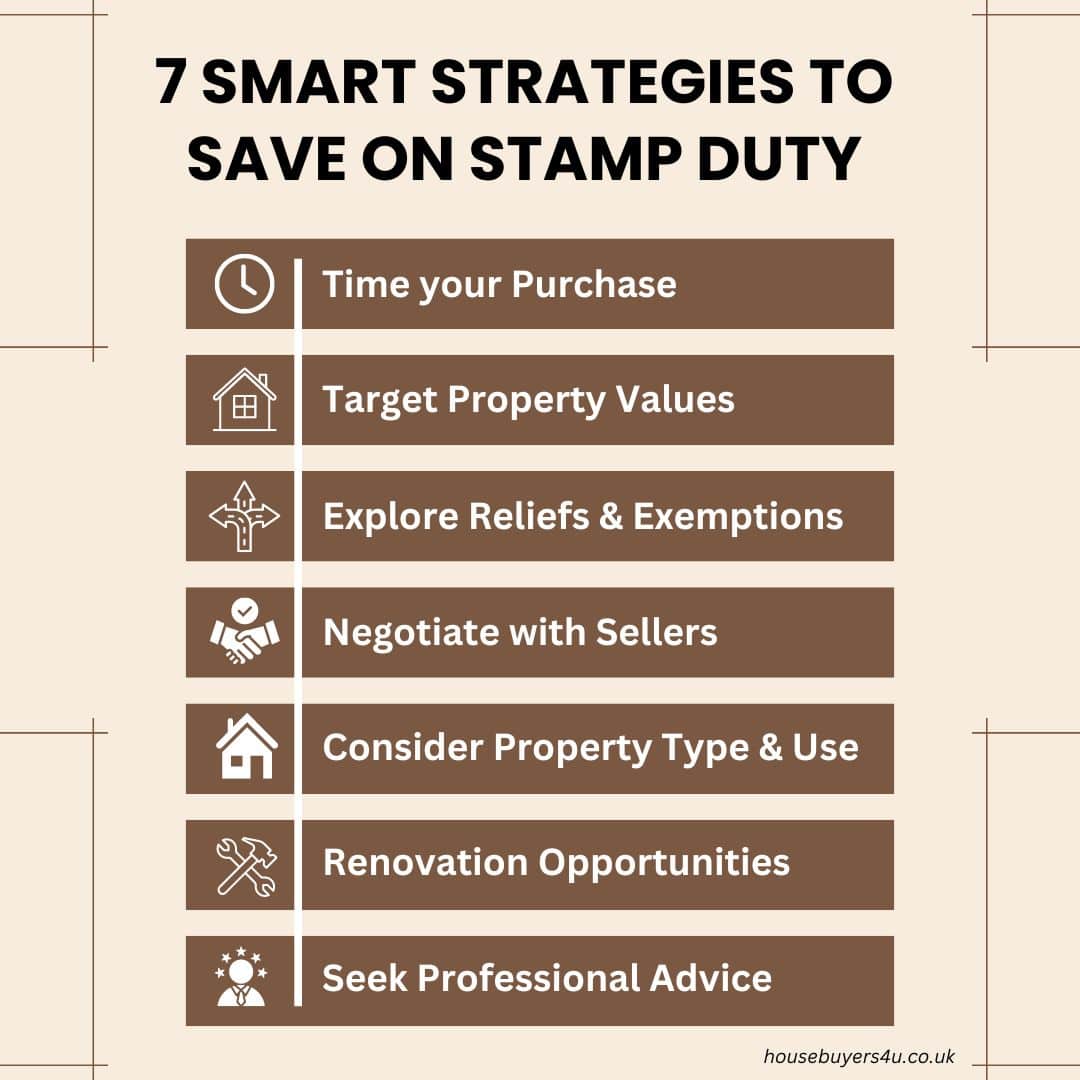What is Stamp Duty? UK Property Tax Explained Simply (2024)
Did you know that stamp duty can add up to tens of thousands of pounds to your property purchase? This article breaks down everything you need to know, including:
-
The latest stamp duty rates and how they impact your budget
-
Expert tips on how to save money with exemptions and reliefs
-
Strategies to time your purchase and reduce your overall tax bill
-
- What Every Homebuyer Should Know About Stamp Duty Tax
- Stamp Duty for Different Buyer Types
- Stamp Duty and Regional Variations
- Paying Stamp Duty
- Stamp Duty Refunds
- Stamp Duty Strategies for Buyers
- Stamp Duty Exemptions and Relief
- Final Thoughts and Key Takeaways
- Frequently Asked Questions about Stamp Duty
What Every Homebuyer Should Know About Stamp Duty Tax
Stamp duty is a tax that buyers in the UK must pay when purchasing a property, including a freehold property. The amount you'll pay depends on the property's value and whether you’re a first-time buyer or a seasoned homeowner.
It’s also worth noting that stamp tax receipts saw a 9% rise, growing from £14.1 billion to £15.36 billion between the 2021-2022 and 2022-2023 financial years, according to official UK government statistics. This rise highlights the growing importance of staying informed about potential stamp duty costs.
How to Calculate Stamp Duty
Calculating stamp duty can seem tricky at first, but it’s straightforward once you break it down. The tax is applied in bands, meaning different portions of the property price are taxed at different rates.
For example, if your property’s value falls into two or more bands, you'll pay a certain percentage on each portion of the price that falls within a specific band.
A stamp duty calculator can help you identify how much stamp duty you need to pay. It is simple to use—just enter the property price, and the calculator will do the rest. Here's a list of some of the official online calculators:
-
England & Ireland
-
Scotland
-
Wales
Stamp Duty for Different Buyer Types
Stamp duty varies for different types of buyers. It is necessary to understand these types so you can plan your property purchase and budget effectively.
Single Property Stamp Duty in England & Northern Ireland
| Property Value | Stamp Duty Rate |
|---|---|
| Up to £250,000 | 0% |
| £250,001 to £925,000 | 5% |
| £925,001 to £1.5 million | 10% |
| Over £1.5 million | 12% |
Note: These rates apply to single residential property purchases in England and Northern Ireland for 2024.
Example of how Stamp Duty works:
Let’s say you’re buying a single residential property worth £800,000.
-
The first £250,000 is taxed at 0%, so no stamp duty is owed on this portion.
-
The next £550,000 (from £250,001 to £800,000) is taxed at 5%.
-
£550,000 x 5% = £27,500
-
Stamp Duty on Second Homes
If you’re buying a second home or an additional property, you’ll need to pay a higher stamp duty rate. An additional 3% is added to the standard rates for each band.
-
Up to £250,000 - 3%
-
Next £675,000 (the portion from £250,001 to £925,000) - 8%
-
Next £575,000 (the portion from £925,001 to £1.5 million) - 13%
-
The remaining amount (the portion above £1.5 million) - 15%
Example:
Let’s say you’re buying a second home worth £800,000.
-
The first £250,000 is taxed at 3%, so:
-
£250,000 x 3% = £7,500
-
-
The next £550,000 (from £250,001 to £800,000) is taxed at 8%, so:
-
£550,000 x 8% = £44,000
-
So, the total stamp duty payable on a second home worth £800,000 would be £7,500 + £44,000 = £51,500.
Related Read: Conveyancing fees explained
Stamp Duty and Regional Variations
Stamp duty isn't the same across the UK, and understanding the differences in each region can help you better plan your property purchase.
Stamp Duty Scotland: Land and Buildings Transaction Tax (LBTT)
In Scotland, stamp duty is replaced by the Land and Buildings Transaction Tax (LBTT). The structure is similar to stamp duty but with different thresholds and rates.
-
Up to £145,000 - 0%
-
£145,001 to £250,000 - 2%
-
£250,001 to £325,000 - 5%
-
£325,001 to £750,000 - 10%
-
above £750,000 - 12%
Learn more here: https://revenue.scot/taxes/land-buildings-transaction-tax
Land Transaction Tax (LTT) in Wales
Wales has its own version of stamp duty known as the Land Transaction Tax (LTT). LTT rates and bands are distinct from those in other parts of the UK.
-
Up to £180,000 - 0%
-
£180,001 up to £250,000 - 3.5%
-
£250,001 to £400,000 - 5%
-
£400,001 to £750,000 - 7.5%
-
£750,001 to £1.5m - 10%
-
Over £1.5m - 12%
Unlike other regions, there are no specific exemptions for first-time buyers in Wales.
Learn more here: https://www.gov.wales/land-transaction-tax-guide
Paying Stamp Duty
Knowing how to pay stamp duty and what happens if you miss the deadline is another important factor when you’re buying property.
Who, When, and How to Pay Stamp Duty
A stamp duty land tax form or the SDLT1 must be completed and submitted to the HMRC by your conveyancer, who will calculate the amount due and file the return on your behalf.
Payment must be settled within 14 days.
Consequences of Late Payment
If you miss the 14-day deadline, HMRC may impose penalties and charge interest on the overdue amount. The longer the delay, the higher the penalties, so it’s important to ensure everything is paid on time.
How to Check Your Conveyancer Has Filed & Paid Your Stamp Duty
To make sure your stamp duty has been properly filed and paid, ask your conveyancer for the for the UTRN (Unique Transaction Reference Number). This is an 11-digit reference code for your transaction.
Related: How to choose a good conveyancer
Stamp Duty Refunds
In certain situations, you may be eligible for a stamp duty refund. For example, if you paid the higher rate for an additional property but then sold your previous main residence within three years, you could claim a refund on the difference.
You’ll need to fill out a specific form on the HMRC website and provide evidence of the sale to claim a refund. Missing the deadline or not providing enough documentation can lead to delay or even prevent your refund.
7 Stamp Duty Strategies for Buyers
- Time your purchase strategically
- Monitor announced rate changes or government incentives.
- Consider waiting if a stamp duty holiday or rate cut is anticipated.
- Be aware of upcoming elections or budget announcements that might affect rates.
- Target property values just under thresholds
- Aim for properties priced just below stamp duty thresholds to minimise tax.
- For example, a £250,000 property incurs no stamp duty, while a £250,001 property would be taxed on the portion above £250,000.
- Explore available reliefs and exemptions
- First-time buyer relief: Offers reduced rates for properties up to £625,000.
- Multiple dwellings relief: Can reduce stamp duty when buying multiple properties in a single transaction.
- Check if you qualify for any specific exemptions based on your circumstances.
- Negotiate with sellers
- Try to negotiate with sellers to cover part or all of the stamp duty cost.
- Consider requesting a price reduction equivalent to the stamp duty amount.
- In a buyer's market, sellers may be more willing to contribute to these costs.
- Consider property type and use
- Mixed-use properties (e.g., a shop with a flat above) may qualify for lower non-residential stamp duty rates.
- Certain types of property, like houseboats or mobile homes, may not be subject to stamp duty.
- Renovation opportunities
- Consider purchasing a lower-value property that needs renovation.
- This approach can potentially reduce stamp duty while allowing you to increase property value through improvements.
- Seek professional advice
- Consult with a tax advisor or solicitor specialising in property transactions.
- They can help explore all available options and ensure compliance with current regulations.
- Professional advice is crucial for complex situations or high-value purchases.
While these strategies can be helpful, always consider your overall financial situation and long-term goals when making property decisions.
Stamp Duty Exemptions and Relief
While stamp duty is a significant cost when buying property, there are several exemptions and relief options available that can help reduce the amount you need to pay.
First-Time Buyers Relief
First-time buyers can benefit from a special relief that significantly reduces the amount of stamp duty payable.
If you're a first-time buyer purchasing a property up to £625,000, you won't pay any stamp duty on the first £250,000. For the remaining amount up to £625,000, a reduced rate applies.
This relief is designed to make it easier for first-time buyers to get onto the property ladder, providing substantial savings, especially in areas where property prices are high.
Other Exemptions and Special Cases
There are several other exemptions and special cases where stamp duty relief might apply. Here are some of them:
-
Properties left in a will are generally exempt from stamp duty.
-
If the freehold property is less than £40,000.
-
If the property is transferred after a divorce or dissolution of a civil partnership.
-
If it is a new or assigned lease of 7 years or more and the premium is less than £40,000, while the annual rent is less than £1,000.
Note: You can no longer claim SDLT relief for multiple dwellings. Know more about it here: https://www.gov.uk/stamp-duty-land-tax/reliefs-and-exemptions
Tip: It's important to check the specific criteria for these exemptions, as they can offer substantial financial benefits.
Final Thoughts & Key Takeaways
Stamp duty is a key factor in property transactions, affecting your overall costs. Staying up-to-date with rate changes and exemptions can help you manage these costs effectively. By understanding the available reliefs and planning strategically, you can potentially reduce your stamp duty liability.
Key Takeaways:
-
First-time buyers and specific cases may benefit from significant stamp duty reliefs and exemptions.
-
Timing your property purchase around potential rate changes can lead to substantial savings.
-
Always verify that your stamp duty has been correctly filed and paid to avoid penalties.
Frequently Asked Questions about Stamp Duty



